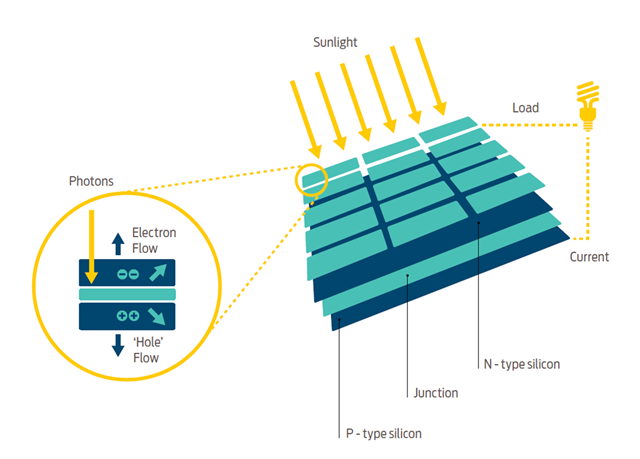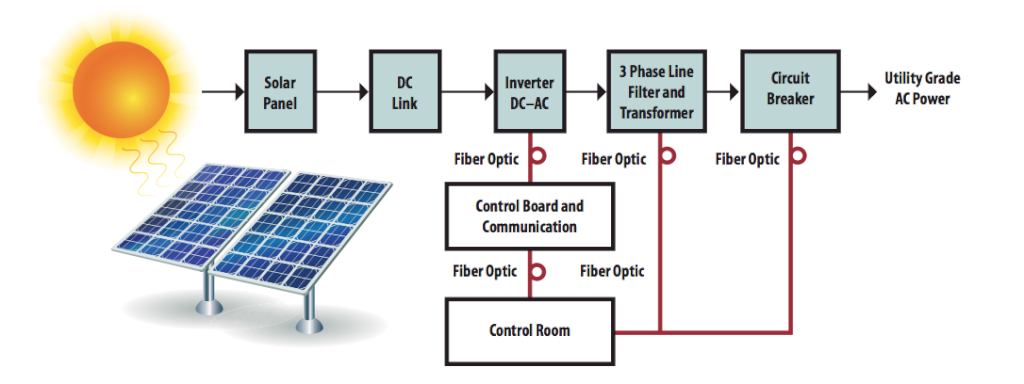Solar energy works by capturing the sun’s energy and turning it into electricity for your home or business. Solar energy is radiant light and heat from the Sun that is harnessed using a range of ever-evolving technologies such as solar heating, photovoltaics, solar thermal energy, solar architecture, molten salt power plants and artificial photosynthesis. Our sun is a natural nuclear reactor. It releases tiny packets of energy called photons, which travel the 93 million miles from the sun to Earth in about 8.5 minutes. Every hour, enough photons impact our planet to generate enough solar energy to theoretically satisfy global energy needs for an entire year.
Currently photovoltaic power accounts for only five-tenths of one percent of the energy consumed in the United States. But solar technology is improving and the cost of going solar is dropping rapidly, so our ability to harness the sun’s abundance of energy is on the rise.
A 2019 report from the International Energy Agency shows that solar has become the world’s fastest-growing source of power – marking the first time that solar energy’s growth has surpassed that of all other fuels. In the coming years, we will all be enjoying the benefits of solar-generated electricity in one way or another.

Solar panels are one of the most common forms of renewable technology and they work by converting the sun's energy into electricity. Here's how they work:-
When photons hit a solar cell, they knock electrons loose from their atoms. If conductors are attached to the positive and negative sides of a cell, it forms an electrical circuit. When electrons flow through such a circuit, they generate electricity. Multiple cells make up a solar panel, and multiple panels (modules) can be wired together to form a solar array. The more panels you can deploy, the more energy you can expect to generate.Simply put, a solar panel works by allowing photons, or particles of light, to knock electrons free from atoms, generating a flow of electricity. Solar panels actually comprise many, smaller units called photovoltaic cells. ... This all adds up to an electric field at the junction between the silicon layers.

Solar cells can be classified into first, second and third generation cells. The first generation cells—also called conventional, traditional or wafer-based cells—are made of crystalline silicon, the commercially predominant PV technology, that includes materials such as polysilicon and monocrystalline silicon.
Solar photovoltaics are made with a number of parts, the most important of which are silicon cells. Silicon, atomic number 14 on the periodic table, is a nonmetal with conductive properties that give it the ability to convert sunlight into electricity. When light interacts with a silicon cell, it causes electrons to be set into motion, which initiates a flow of electricity. This is known as the “photovoltaic effect.” However, silicon cells alone can’t provide electricity for your home. They are paired with a metal casing and wiring, which allow the solar cell’s electrons to escape and supply useful power. Silicon comes in a number of different cell structures: single cell (monocrystalline), polycrystalline or amorphous forms, most commonly associated with thin film solar panels.
Photovoltaic (PV) solar panels are made up of many solar cells. Solar cells are made of silicon, like semiconductors. They are constructed with a positive layer and a negative layer, which together create an electric field, just like in a battery.
A solar inverter takes the DC electricity from the solar array and uses that to create AC electricity. Inverters are like the brains of the system. Along with inverting DC to AC power, they also provide ground fault protection and system stats, including voltage and current on AC and DC circuits, energy production and maximum power point tracking.
Central inverters have dominated the solar industry since the beginning. The introduction of micro-inverters is one of the biggest technology shifts in the PV industry. Micro-inverters optimize for each individual solar panel, not for an entire solar system, as central inverters do. This enables every solar panel to perform at maximum potential. When a central inverter is used, having a problem on one solar panel (maybe it’s in the shade or has gotten dirty) can drag down the performance of the entire solar array. Micro-inverters, such as the ones in SunPower’s Equinox home solar system, make this a non-issue. If one solar panel has an issue, the rest of the solar array still performs efficiently.

Here’s an example of how a home solar energy installation works. First, sunlight hits a solar panel on the roof. The panels convert the energy to DC current, which flows to an inverter. The inverter converts the electricity from DC to AC, which you can then use to power your home. It’s beautifully simple and clean, and it’s getting more efficient and affordable all the time.
However, what happens if you’re not home to use the electricity your solar panels are generating every sunny day? And what happens at night when your solar system is not generating power in real time? Don’t worry, you still benefit through a system called “net metering.”
A typical grid-tied PV system, during peak daylight hours, frequently produces more energy than one customer needs, so that excess energy is fed back into the grid for use elsewhere. The customer gets credit for the excess energy produced, and can use that credit to draw from the conventional grid at night or on cloudy days. A net meter records the energy sent compared to the energy received from the grid. Find out more.